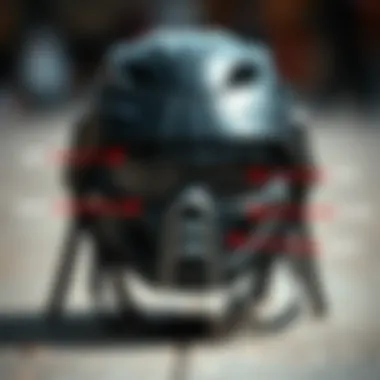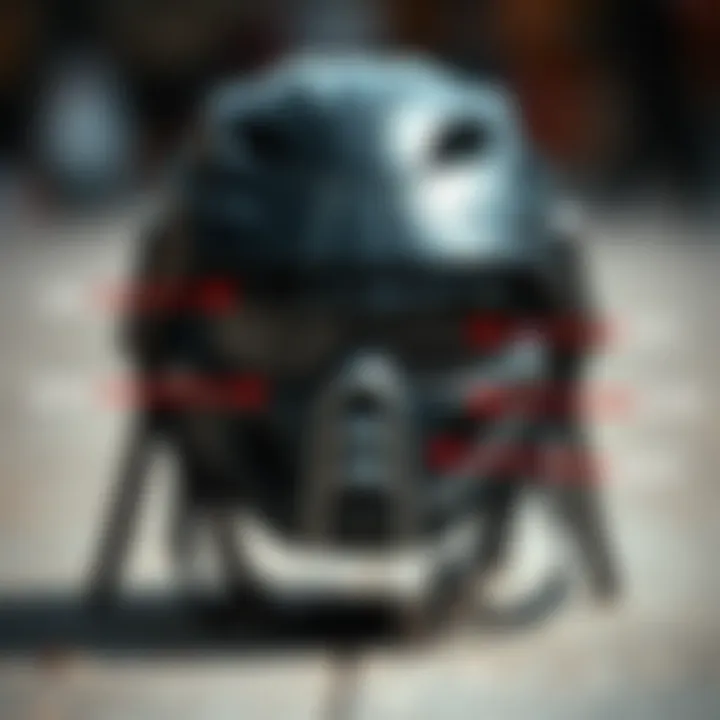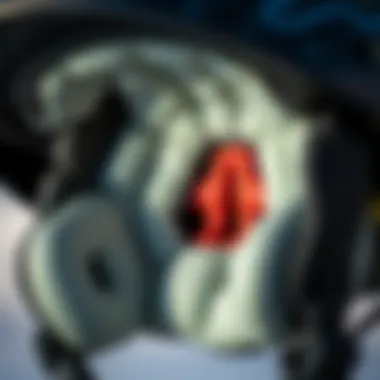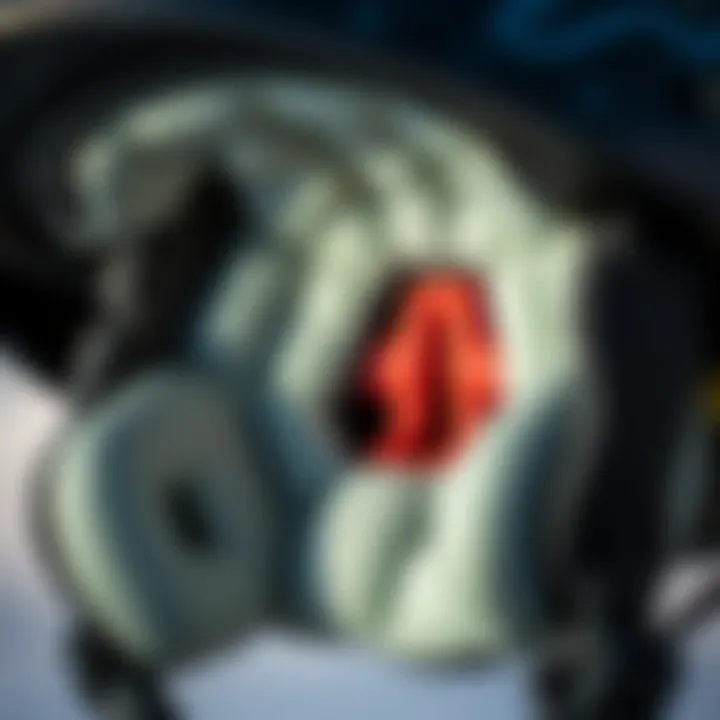Exploring the Predator Skate Helmet: A Comprehensive Guide


Intro
Kiteboarding combines the thrill of surfing with the lift of a kite, empowering enthusiasts to glide across the water with grace and agility. However, amid the excitement lies the undeniable fact that safety remains paramount. When it comes to protective gear, a reliable helmet like the Predator skate helmet can make all the difference between a day of fun on the waves and a visit to the emergency room.
This guide takes you through the nitty-gritty of the Predator helmet, dissecting its design and functionality, while also highlighting how it stands up against its competitors. Those who ride the winds and waters need gear that doesn’t just look good but works hard to keep them safe. This article offers keen insight into various features of the Predator helmet, ensuring that whether you're a novice just starting or an experienced rider, you can make informed decisions on your gear.
Gear and Equipment
In the world of kiteboarding, having the right gear is akin to having a trusty compass while navigating uncharted waters.
Essential Kiteboarding Gear for Beginners
For those just breaking into the sport, familiarity with essential equipment can set the stage for successful outings. The following items are indispensable:
- Kite: The heart of kiteboarding; ensure it's suitable for your size and skill level.
- Board: Choose one that complements your style; a bigger board can offer added stability.
- Harness: A comfortable harness helps with control and efficiency while riding.
- Safety Gear: Alongside the Predator helmet, consider impact vests and wrist guards for full protection.
- Leash: Keeps your board secure in case of a wipeout, avoiding potential hazards to yourself and others.
In addition to these, investing in a solid wetsuit tailored for your climate will enhance your overall experience, keeping you cozy and free to enjoy long days on the water.
Advanced Equipment for Experienced Riders
As riders progress, their needs evolve. Experienced kiteboarders often look for high-performance gear that enhances their abilities:
- High-Aspect Ratio Kites: These kites offer improved performance, especially in low wind conditions.
- Directional Boards: Perfect for those who wish to glide effectively, providing better responsiveness.
- Footstraps or Bindings: Depending on preference, they can offer better connection to the board, allowing for advanced maneuvers.
- Smart Helmets: Helmets integrated with communication systems aid in team navigation and safety during sessions.
When diving into the array of options available, always prioritize quality and functionality over merely aesthetic choices.
"The upper crust of riding is more than just talent; it’s about having the right tools for the job."
Finale
Equipped with the right gear and knowledge, kiteboarders can better prepare themselves for the exhilarating rides that await. With the Predator skate helmet as a central piece of safety equipment, riders can push their limits with confidence, knowing that their protection is top-notch. don’t let improper gear cut your adventures short; invest in quality and enjoy the freedom of the open waters.
Prolusion to the Predator Skate Helmet
In the world of kiteboarding, safety isn’t just a precaution; it’s a necessity. The Predator skate helmet emerges as a crucial tool in ensuring riders protect one of their most valuable assets—their heads. This section highlights the relevance of the Predator helmet by delving into its core aspects, which encompass design, comfort, and safety features tailored for both seasoned kiteboarders and newcomers alike.
Understanding the essence of this helmet goes beyond just knowing its name; it’s about grasping how it enhances the kiteboarding experience. Whether one’s soaring through waves or maneuvering against wind currents, the helmet stands as a reliable companion on these adventures. This introduction sets the stage for deeper exploration of the helmet's attributes, versatility, and why it’s regarded as a staple in the kiteboarder’s gear lineup.
What is the Predator Skate Helmet?
The Predator skate helmet is designed specifically for those who thrive on adrenaline. Its construction focuses on delivering robust protection while allowing maximum freedom of movement. Made with high-quality materials, the helmet features a sleek, aerodynamic design that minimizes drag during high-speed rides. What sets it apart from standard helmets is its dual-purpose design, which not only caters to skateboarders but also meets the rigorous demands of water sports enthusiasts—particularly kiteboarders.
Key Features of the Predator Helmet:
- High-Impact Shell: Built to withstand falls and bumps.
- Lightweight yet Durable: Ensures comfort without sacrificing protection.
- Customizable Fit: Adjustable components for a snug fit across various head shapes.
Kiteboarding is unpredictable, and the conditions can change in a blink. Thus, having a helmet like the Predator can mean the difference between a thrilling ride and a dangerous accident.
The Importance of Head Protection in Kiteboarding
Head injuries can pose serious risks not only to ones’s physical well-being but also to their long-term abilities. In kiteboarding, the thrill of gliding over water comes with visceral challenge; riders face the potential of collisions, falls, and unpredictable wind shifts. Whether it’s a crash landing from an aerial maneuver or a sudden toss caused by turbulence, adequate head protection is non-negotiable.
Why It Matters:
- Injury Prevention: Helmets significantly reduce the risk of concussions and more severe brain injuries.
- Legal Requirements: In some locales, wearing a helmet while engaging in water sports is mandatory to comply with local regulations.
- Building Confidence: Knowing you are well-protected allows riders to push their limits, enhancing both skills and enjoyment.
In essence, choosing the right helmet is not merely about the gear; it’s about making a commitment to personal safety while pursuing an exhilarating sport. With the Predator skate helmet, kiteboarders gain more than just a protective covering; they obtain peace of mind that goes hand in hand with their passion for adventure.
Design Features of the Predator Helmet
The design of the Predator helmet isn’t just about looking good; it's about function and safety, especially when you’re maneuvering through the waves. The features incorporated into the design matter immensely for performance, protection, and comfort. For kiteboarders, every detail can spell the difference between an enjoyable session and a day cut short by discomfort or worse. Here, we explore the critical elements of the Predator helmet's design, breaking it down into material composition, aerodynamic properties, and ventilation systems.
Material Composition and Construction
When considering the materials used in the manufacturing of the Predator helmet, one cannot overlook the significance of their resilience and lightweight qualities. The outer shell often utilizes a polycarbonate blend, known for its toughness and impact resistance. This outer layer is crafted to withstand high-impact scenarios that kiteboarders frequently face. On the inside, materials such as expanded polystyrene (EPS) are commonly employed to absorb shocks and guard against concussion-related injuries.
Moreover, this layered construction is not arbitrary; it’s engineered with a purpose in mind. For example, the strategic layering aids in minimizing weight while maximising protection. Riding with a helmet that's too heavy can lead to fatigue, detracting from the overall experience. Thus, the construction doesn’t just safeguard; it also enhances performance by being less cumbersome.
Aerodynamic Considerations
The Predator helmet is designed with aerodynamic performance in mind. In sports like kiteboarding where speed is part of the thrill, resistance from wind can be a real drag. A well-designed helmet minimizes this drag. The shape of the helmet has been optimized to cut through air, helping maintain a streamlined silhouette. This consideration means that riders can focus on their technique rather than battling against the wind.
But it goes beyond shape; features like a narrow chin strap and low profile are crucial too. Together, they mitigate turbulence, meaning that the helmet stays put during high-speed maneuvers. It’s not just about looking sleek—there's a science behind this, derived from tests in wind tunnels to ensure that the helmet performs flawlessly. For those pushing the limits, this aspect of design can mean securing a critical edge over competitors.
Ventilation Systems
Ventilation is another significant design feature that cannot be overlooked when talking about helmet functionality. Riding under the sun and feeling the wind rush by is part of the kiteboarding experience, but wearing a helmet can sometimes feel like a recipe for overheating. To combat this, the Predator helmet incorporates advanced ventilation channels strategically placed around the helmet.


These channels are not just random holes; they’re a well-thought-out network that allows air to flow freely while maintaining structural integrity. As a rider carves through the waves, these systems work to keep the wearer cool and comfortable, preventing distracting sweat accumulation.
Additionally, high-quality sweat-wicking liners come into play to absorb moisture, further enhancing comfort levels. This feature ensures the user remains focused on the ride rather than on an uncomfortable helmet. All these elements work in harmony to create a helmet that feels as good as it functions.
"The right helmet can make you feel invincible, enhancing your confidence and performance on the waves."
In summary, the design features of the Predator helmet are crafted with careful consideration, focusing on an ideal blend of safety, efficiency, and comfort. These elements work together to create a helmet that stands out in the competitive market, catering to the needs and demands of kiteboarding enthusiasts.
Safety Features and Standards
When it comes to engaging in activities like kiteboarding, the importance of robust safety measures cannot be overstated. The Predator skate helmet stands out in this regard, embodying a host of safety features designed to protect users from potential head injuries. With extreme sports, mishaps can occur in the blink of an eye, making understanding these safety standards essential for anyone passionate about adventure on the water. This section dives deep into the impact resistance ratings and the certification bodies that endorse helmet compliance, showcasing how these aspects contribute to the overall reliability of the helmet.
Impact Resistance Ratings
Impact resistance ratings detail how well a helmet can withstand sudden jolts or impacts. These ratings provide a quantifiable measure of safety, guiding users in selecting the right protection for their activities. The Predator helmet features advanced materials that not only absorb shocks but also help disperse the impact forces, incredibly vital when high speed is involved, like during kiteboarding.
Helmet ratings typically fall under a recognizable standard system, which gives potential users a clear idea of what to expect. The common tests include the Snell, CPSC, and ASTM protocols. In a nutshell:
- Snell: Often considered the gold standard for safety, the Snell Foundation regularly updates its protocols to adapt to emerging technologies and safety findings.
- CPSC (Consumer Product Safety Commission): This certification ensures that the helmet meets specific thresholds related to impact and retention.
- ASTM (American Society for Testing and Materials): This tests additional elements that cater specifically to sports helmets.
The Predator helmet typically achieves high ratings across these tests, making it a reputable choice among kiteboarding enthusiasts. The science behind these ratings is a boon for anyone keen on safeguarding their noggin during daring feats.
Certification Bodies and Compliance
Certification bodies are the watchdogs of helmet safety, ensuring that manufacturers adhere to stringent guidelines designed to protect users. The Predator helmet does not skimp on compliance, aiming to meet or even exceed set industry standards. Organizations like the Snell Foundation and CPSC have laid down rules that manufacturers must follow, thus bolstering the reliability of products like the Predator.
Key Certification Bodies:
- Snell Memorial Foundation: Focuses on enhancing the protection technology in helmets with rigorous testing.
- Consumer Product Safety Commission: Provides oversight for consumer protection and runs checks on market-sold products.
- ASTM International: This is vital in maintaining set standards for many materials currently used in helmets, including those specifically designed for extreme sports like kiteboarding.
For users, it's crucial to look for helmets that boast these certification marks. They symbolize that the helmet has been scrutinized and tested, giving kiteboarders a layer of confidence when they hit the waves. In a world teeming with options, understanding certifications can significantly simplify the decision-making process.
In summary, the safety features and standards associated with the Predator skate helmet provide layers of protection that outdoor enthusiasts can trust. When the wind is howling and the waves are crashing, knowing that you are using a certified helmet can make all the difference.
Comfort and Fit
When it comes to gear for extreme sports like kiteboarding, comfort and fit rank high on the list of priorities. A helmet that fits snugly—without feeling like a vice—is crucial for performance and safety. It keeps you focused on your ride rather than constantly adjusting your gear, which can be a real distraction out on the water. Not only does a good fit enhance comfort levels, but it also ensures that the helmet stays in place during those unexpected tumbles or strong gusts of wind.
A helmet that's too loose might slide around or even come off entirely, while one that's too tight can cause discomfort or headaches, leaving you less capable when you need your wits about you. A proper fit can significantly enhance the overall experience for kiteboarders, enabling them to push their limits without the nagging concern of their safety gear failing.
"A well-fitted helmet can mean the difference between enjoying the ride and having your focus split by discomfort."
Adjustability and Sizing Options
The Predator Helmet shines in its adjustable sizing options. With numerous padding configurations and a ratchet adjustment system, it cater to a variety of head shapes and sizes. This ensures that, whether you’re a seasoned rider or a newbie, you can find a fit that feels just right.
Common features to look for in adjustability include:
- Dial systems: Allow for quick adjustments on-the-go.
- Multiple padding layers: For personalized comfort and snugness.
- Strap systems: To ensure the helmet stays secure, even when you're barreling through the waves.
Being able to tailor your helmet to your head can make a real difference, especially during those long sessions on the water. A good adjustability feature not only boosts comfort but also enhances safety, securing the helmet firmly in place. Plus, it helps keep those humble bragging rights intact by making sure you look good while doing it!
Liner Materials and Comfort Levels
The interior of the Predator Skate Helmet is where the magic happens in terms of comfort. The choice of liner materials greatly impacts how comfortable the helmet feels during use. Higher quality liners can absorb shock while providing a snug yet soft fit.
Some noteworthy liner materials include:
- EPS foam: Lightweight and shock-absorbent, providing essential safety while minimizing weight.
- Memory foam: Offers excellent comfort as it molds to the unique contours of your head, providing that all-important personalized feel.
- Cooling gels: Designed to manage heat during intense rides, helping to wick sweat away and keep your head cool.
These materials not only increase the level of comfort but also contribute to improved safety features. A comfortable lining can help you confidently tackle high-speed maneuvers.
In summary, when selecting a helmet, the comfort and fit should never be an afterthought. A well-fitting helmet equipped with adjustable options and high-quality liner materials can significantly enhance both your performance on the board and your overall enjoyment of the sport.
Performance in Various Conditions
When discussing the performance of the Predator Skate Helmet, one cannot overlook the varying environmental conditions that a kiteboarder may face. This section explores how different weather scenarios can affect performance and comfort, evaluating the helmet’s design considerations for both wet and dry conditions as well as cold weather adaptability. Understanding these elements not only boosts safety but also enhances the overall kiteboarding experience.
Wet vs. Dry Conditions
Kiteboarding often leads enthusiasts across diverse terrains, including those on and off the water. Thus, understanding how the Predator helmet copes with wet conditions is crucial. The aerodynamic design helps maintain stability even when wind and rain are at their worst. This is more than just a nifty feature; it plays a significant role in reducing drag and keeping the rider's head secure.
In wet conditions, the helmet’s exterior is crafted from waterproof materials that resist water absorption. Notably, this prevents the helmet from becoming excessively heavy when wet. Moreover, the design includes drainage channels that allow water to escape easily, ensuring that users won’t experience a buildup of moisture that could lead to discomfort.
On the flip side, in dry weather, the helmet excels in providing ventilation. The built-in airflow systems are designed to encourage airflow around the head, preventing overheating during intense rides under the sun. Striking a balance between ventilation in dry conditions and water resistance during wet ones showcases the thoughtful construction of the Predator helmet.
- Key Attributes for Wet Conditions:
- Key Attributes for Dry Conditions:


- Waterproof materials to prevent waterlogging.
- Drainage channels for quick water release.
- Ventilation systems to enhance airflow.
- Lightweight materials to ensure comfort.
"The Predator helmet truly understands the kinetic nature of kiteboarding, adapting seamlessly to both water and air challenges."
Cold Weather Adaptability
Kiteboarding is not solely confined to sunny beaches; many practitioners venture out during the frigid winter months. In such conditions, wearing a helmet that can retain warmth without compromising safety is paramount. The Predator helmet incorporates thermal insulation within its liners, a design that allows for better temperature regulation. This feature works by trapping heat while still providing ample ventilation to avoid moisture build-up from sweat.
Furthermore, the exterior shell is engineered to resist low temperatures and not become brittle or compromised. Riders venturing into colder waters can appreciate the additional warmth without sacrificing performance and safety. The snug fit provided by adjustable straps is crucial here, ensuring the helmet stays in place regardless of conditions.
Overall, the ability to perform in both wet and cold conditions assures users that the Predator helmet is designed with the full spectrum of adventure in mind. Whether navigating through heavy rain or gliding over frozen waters, this helmet stands as a reliable companion for kiteboarders.
- Cold Weather Features:
- Thermal liners to keep heat in.
- Durable shell to resist cold impact.
By tailoring performance features to meet the rigors of various weather conditions, the Predator Skate Helmet not only prioritizes user safety but assures comfort for kiteboarders, whatever the environment throws their way.
Comparative Analysis with Other Helmets
When discussing protective gear, particularly in high-impact sports like kiteboarding, it's crucial to measure the capabilities of various helmets against one another. This comparative analysis not only highlights the strengths and weaknesses of the Predator Skate Helmet but also allows us to better appreciate its unique features. Knowing the competition helps kiteboarders, whether beginners or seasoned pros, make informed decisions that enhance their safety and performance.
Market Competitors
The landscape is dotted with helmets from different brands that cater to a variety of needs and preferences in the sport. Here are a few noteworthy competitors that come to mind:
- Pro-Tec Classic certified – Known for its classic design and solid construction, it’s appreciated by many for freestyle kiteboarding.
- Gath Gedi Surf Helmet – A favorite among water sport lovers, it excels in flotation and comfort for long sessions.
- Shred Ready Standard – Offers full coverage with a cute twist on style, providing robust protection while still looking slick on the water.
Each of these helmets brings something to the table. For instance, while Pro-Tec’s model shines in its traditional fit, the Gath helmet focuses on comfort during prolonged use. The Shred Ready Standard, on the other hand, may appeal to those wanting a balance of style and function.
The distinction in these helmets’ designs and functionalities invites users to weigh factors like style, weight, and price against their specific needs for safety and performance. Each competitor offers various options regarding fit and comfort, addressing the fact that not every head is the same.
Pros and Cons of Alternative Options
Examining alternative helmets to the Predator model presents a mixed bag of advantages and disadvantages. Let’s break down the positives and negatives of some market competitors:
Pros:
- Variety in Design: Many brands come with different styles and colors, allowing users to express their personal flair.
- Specialized Features: Some helmets like the Gath Gedi offer floating capabilities, especially useful in rough waters.
- Price Range: There are more budget-friendly options available for newcomers who may not yet want to commit to a high-end helmet.
Cons:
- Quality Assurance: Lower price points often mean sacrificing some quality, which is a gamble that could risk safety.
- Fitment Issues: Not all brands cater well to different head shapes, leading to discomfort during use.
- Lack of Advanced Safety Technologies: Competitive helmets may not incorporate the latest advancements in impact resistance and other safety features found in the Predator helmet.
User Experiences and Feedback
User feedback provides invaluable insights when it comes to evaluating the effectiveness of the Predator skate helmet. Understanding how the helmet performs in real-world situations is essential for both novice and seasoned kiteboarders. This section sheds light on user experiences and feedback to help prospective purchasers make informed decisions.
General User Reviews
Reviews from actual users serve as a litmus test for any product. Regarding the Predator skate helmet, common themes often surface in the feedback given by users. Many enthusiasts highlight the effectiveness of its safety features. For instance, one user noted, "I've had multiple falls while kiteboarding, but the helmet has held up brilliantly, absorbing impacts without a scratch on my head." This feedback underscores the helmet’s primary function: to provide reliable protection in high-stakes conditions.
Another aspect frequently mentioned in user reviews is comfort. Several riders appreciate its snug fit and adjustable features, saying things like, "I can wear it for hours without feeling any pressure points, which is crucial when I’m spending whole days on the water." This focus on comfort during extended use cannot be overstated, as fatigue can severely impact performance.
In addition to comfort, users often praise the helmet's ventilation system. One consumer shared, "I was worried it might get too hot, but the airflow is fantastic, even on scorching days." Such remarks are crucial for those who spend a lot of time in the sun, making the helmet a preferable choice for those sunny kiteboarding escapades.
Professional Endorsements
When professionals endorse a product, it indicates a level of trustworthiness and credibility that cannot be overlooked. Many kiteboarding instructors and pro athletes have publicly shared their thoughts on the Predator helmet. They often emphasize aspects like durability and performance under pressure.
One well-known kiteboarding instructor remarked, "In my years of teaching, I've seen a lot of gear come and go, but the Predator consistently impresses with its impact resistance and material quality." Such endorsements from industry veterans make a compelling case for the helmet's reliability.
Professional athletes also frequently highlight the helmet’s design for performance. A noted competitor observed, "It’s not just about safety; the aura of confidence I feel with this helmet makes me ride better." This psychological element plays a significant role in how some users perceive safety gear and its effect on their performance.
Moreover, the relationship between professional endorsements and user experiences is symbiotic. Their insights often resonate with everyday users, creating a ripple effect of trust and credibility. When hobbyists read about elite riders using the Predator helmet, it fosters a sense of assurance that they are making a sound decision.
The combination of user reviews and professional endorsements creates a multi-faceted view of the Predator skate helmet's performance, safety, and comfort.
In short, both general user reviews and endorsements from professionals contribute to a comprehensive understanding of the Predator skate helmet. This section makes it evident that investing in this gear leads to better safety and enhanced performance on the water. Prospective buyers must evaluate these feedback channels seriously as they consider their options.
Maintenance and Care Tips
Ensuring the longevity and best performance of the Predator Skate Helmet hinges not just on its initial choice, but equally on how one maintains and cares for it. Proper maintenance is essential because it can significantly impact the helmet's effectiveness in providing safety during kiteboarding adventures. A well-cared-for helmet not only looks good but also performs better, offering the protection and comfort needed when riding the waves.
Attention to care details can prevent premature wear and tear, safeguarding your investment. A helmet is a protective piece of equipment, and keeping it in top shape means it’s always ready to take on whatever the conditions throw at you. Care tips make the difference between good performance and a helmet that could let you down when it counts.


Cleaning Recommendations
Cleaning your helmet isn’t just about keeping it aesthetically pleasing; it’s also crucial for ensuring the materials maintain their integrity. Start with the basics:
- Inspect Regularly: After each session, give your helmet a quick check. Look for any visible dirt, scrapes, or damage.
- Gentle Wash: Use mild soap with warm water for cleaning. Avoid harsh chemicals as they can damage the helmet's materials. That includes avoiding bleach or alcohol-based products, which might break down protective coatings.
- Soft Cloth: Utilize a soft cloth or sponge to gently scrub the surfaces. This is important for the outer shell and any internal padding. Be meticulous but gentle to avoid scratches on the surface.
- Drying: After washing, ensure the helmet dries completely before using or storing it. Place it in a well-ventilated area away from direct sunlight, as heat can warp or damage the structure.
A clean helmet means a better fit and better comfort for your riding experiences. Regular cleaning not only enhances the look but ensures hygiene, especially if you're frequently exposed to saltwater or sweat.
Storage Guidelines
Storing your helmet properly is key to preserving its shape and functionality. Following certain storage practices can also prevent unnecessary damage:
- Cool, Dry Place: Store your helmet in a cool and dry environment. Humidity or excessive heat can compromise the materials.
- Helmet Bag: Invest in a protective helmet bag to shield it from dust and minor impacts. This is a simple step that can save your helmet from scratches or dents when not in use.
- Avoid Pressure: Don’t stack heavy objects on top of the helmet or store it in a position where it can be crushed. This impact could lead to structural damage that may not be immediately visible.
- Away from Direct Sunlight: Prolonged exposure to direct sunlight can cause fading and degradation of materials. Always put it away from windows that get a lot of sun.
- Regular Airing: If you don’t use your helmet for an extended period, give it a chance to air out. Letting it breathe can prevent any musty smells from setting in, which is especially beneficial if storing wetsuits or other gear nearby.
Proper maintenance and care can extend the life of your Predator Skate Helmet, ensuring you stay safe while enjoying your time on the water.
Purchasing Considerations
When it comes to gear for activities as thrilling as kiteboarding, the choice of your helmet is not something to take lightly. The Predator Skate Helmet stands out in the ever-evolving landscape of safety gear, so understanding the purchasing considerations can make or break your experience on the water. With that in mind, let’s delve into the critical elements that will guide your decision-making process.
Where to Buy
Finding the right place to purchase your Predator helmet can be quite the adventure itself. Many well-known sporting goods stores carry this brand, both in physical shops and online. Retailers like REI and Dick's Sporting Goods often have a range of options. Alternatively, niche online stores that focus specifically on kiteboarding equipment might have the best selection.
If you prefer a personal touch, visiting local shops that specialize in water sports can provide the benefit of trying the helmet on before buying. Here, experienced staff often offer valuable insights based on your specific needs, which is particularly helpful if you’re new to the activity.
For a more straightforward approach, you could consider well-regarded online platforms like Amazon or the official Predator website. They usually have user reviews, which can be handy – but no substitute for firsthand experience.
Price Range Analysis
Let’s talk numbers. The price of the Predator Skate Helmet can vary, and knowing the market would serve you well. Generally, you’ll find that most helmets fall within a range of $70 to $150. It's crucial to understand what you're paying for:
- Economical Models: Usually around $70 to $90, these helmets offer decent safety but might skimp on advanced features or durability.
- Mid-Range Options: Starting from $100, they typically include better materials and ventilation systems, providing a more comfortable fit for long sessions.
- Premium Helmets: Often priced $120 and above, these helmets are engineered with cutting-edge technology and rigorous safety standards.
It’s not just about the sticker price—consider the overall value. A helmet is an investment in not only your safety but also your enjoyment of the sport. Remember, you might spend less upfront on a lower-priced helmet, but is it worth it if you have to replace it every season? As they say, “You get what you pay for.” Always balance your budget with the features that might enhance your experience.
"A quality helmet isn’t merely a piece of equipment; it’s an essential partner in the ride of your life."
Ultimately, evaluating where to buy and understanding the price range will arm you with the knowledge to make an informed choice. The Predator helmet is designed for protection and performance, but knowing your options ensures that you don’t just follow the trend, but choose wisely based on what aligns best with your kiteboarding aspirations.
Future Developments in Helmet Technology
Understanding the future directions in helmet technology is essential for anyone who is passionate about kiteboarding and similar sports. As technology evolves, it presents opportunities to enhance safety, comfort, and overall performance. Progress in helmet design doesn't just focus on aesthetics or the latest trends but fundamentally seeks to improve protection under increasingly challenging conditions.
New materials and innovations pave the way for lighter, yet incredibly resilient helmets, ensuring that users are better protected against impacts while experiencing more comfort during wear. Additionally, developments in smart technology are revolutionizing the way helmets interact with the user.
Emerging Technologies
In the world of helmet design, several novel technologies have surfaced, aiming to anticipate and mitigate head injuries more effectively. For instance:
- MIPS Technology: Multi-directional Impact Protection System is gaining attention due to its innovative way of reducing rotational forces during impact. This can offer better protection in accidents that involve severe angle impacts.
- Smart Helmets: Incorporation of Bluetooth technology and built-in communication features are transforming helmets into smart devices. Some models allow users to listen to music or receive calls without removing their helmets, effectively merging safety with connectivity.
- Advanced Ventilation Systems: New vent designs allow for better airflow. This means even in the heat of summer, riders can stay cool, preventing discomfort during long sessions on the water.
- 3D Printing Materials: The emergence of 3D printed helmets is not just about customization but also ensures that helmets can be tailored for individual fit with improved impact absorption properties.
These advancements reflect a shift towards more personalized safety gear in an industry where users have different preferences and needs.
Implications for User Safety
The potential implications of these developments for user safety cannot be understated. As helmet technology continues to advance, users stand to benefit greatly. For example:
- Increased Protection: With innovations like MIPS and enhanced materials, the likelihood of sustaining severe injuries diminishes, even in challenging conditions.
- Customization and Fit: Customized helmets lead to better comfort and safety. A helmet that fits properly is less likely to shift during activity, providing optimal protection from potential impacts.
- Data and Feedback: Some smart helmets can track performance metrics, such as heart rate and activity levels. Access to this data can provide valuable feedback, informing users when they might need to adjust their activity levels or take breaks.
- Awareness and Connectivity: With smart technology, riders can maintain situational awareness while staying connected, which is crucial during adventures that take them far from shore or into uncharted waters.
"Helmet technology is no longer just about the hard shell; it's about how we combine technology and design to enhance safety and user experience."
Epilogue
The significance of the topic of helmet choice cannot be understated, particularly in the world of kiteboarding and other high-impact sports. The Predator skate helmet, with its unique blend of safety, comfort, and performance, stands out as an essential piece of gear for enthusiasts keen on protecting themselves against potential head injuries. In this concluding section, we will summarize the core insights presented throughout the article and share final thoughts aimed at facilitating informed helmet choices among readers.
Summary of Key Insights
Throughout this comprehensive guide, we have explored various aspects of the Predator skate helmet, from its material composition to its safety features. Here are the top takeaways:
- Design Excellence: The helmet’s aerodynamic design and ventilation systems allow for comfort during extended use, making it suitable for outdoor activities.
- Safety Standard Compliance: The adherence to rigorous safety standards, without compromise, is a key selling point of the Predator helmet. Knowing that it meets high-impact resistance ratings provides peace of mind to users.
- User-Centric Features: Customizability in fit through adjustable components ensures that the helmet caters to different head sizes, promoting both comfort and security.
- Performance Across Conditions: Analysis showed that the helmet’s versatility extends to various weather conditions, ensuring it performs well whether in wet or dry climates.
- User Feedback Matters: Listening to both general user reviews and professional endorsements can illuminate the path toward making an informed decision.
Thus, the versatility and advanced features of the helmet highlight its value in not just protecting the head but also enhancing the overall experience of being out on the water.
Final Thoughts on Helmet Choice
In the fast-paced realm of kiteboarding, the difference between an exhilarating ride and a potentially dangerous situation can often come down to the choice of helmet. The Predator skate helmet effectively bridges the gap between safety and performance, so it stands as a top contender worth considering.
When selecting a helmet, factors such as fit, comfort, and safety ratings should weigh heavily in the decision-making process. Additionally, those out in the adventure-seeking landscape of water sports should consider the environment in which they are operating, as performance may vary.
It's crucial to remember that the right helmet is not just about having the latest model but about finding a balance that resonates with your personal style and safety needs. Therefore, take the time to research, read reviews, and even try on helmets when possible. The goal is to enjoy every moment on the water while knowing you've invested in your safety.
"Headgear is the best defense against the unforgiving elements of nature as well as the unpredictability of water sports. Choose wisely."
Ultimately, choosing a helmet like the Predator can provide not just protection, but also confidence—ensuring that your focus remains where it belongs: on enjoying the thrill of the sport.



